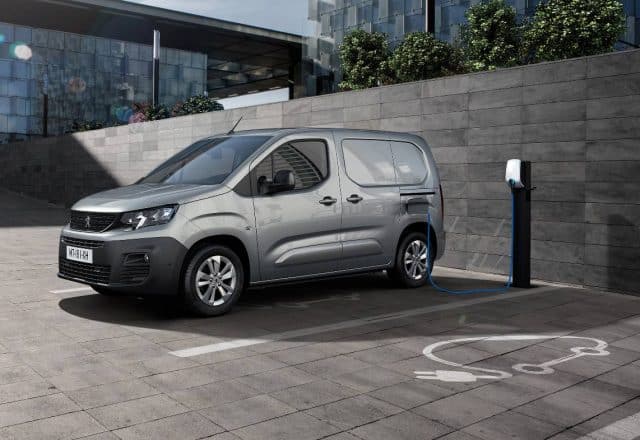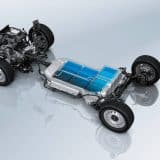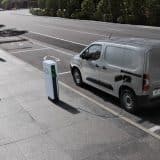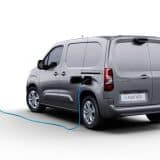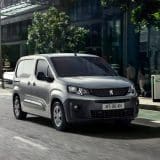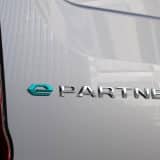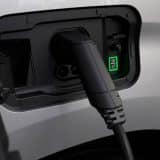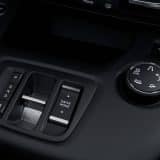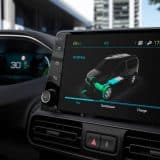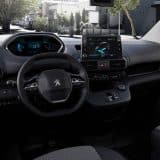Pros:
- Battery range
- Equipment
- Styling
Cons:
- Battery charging time
- Price
The Peugeot e-Partner is a well-designed and well-made electric van that goes on sale in late 2021. It’s the sibling to the likes of the Vauxhall Combo-e and the Citroen e-Berlingo. There’s a lot to like with a range of 171 miles and it has the firm’s unique i-Cockpit interior to help set it apart from its close relations. Also, this latest version of the e-Partner is nothing like the previous model in handling, comfort and battery range.
The Peugeot e-Partner has a 100kW electric motor producing 136 HP and there’s a 50kWh battery pack delivering a range of 171 miles. It’s a quick van from a standing start with a top speed of 80 mph. But why buy the e-Partner and not the Combo-e or the e-Berlingo? Part of the answer may be down to the dealer network and whether there is one close to you, but there’s a lot to like about the e-Partner and its list of equipment – and if you like the i-Cockpit then the Peugeot electric van has the edge.
PEUGEOT SAYS
The new Peugeot e-Partner joins the existing zero-emissions Peugeot e-Expert van. With a 100% electric range of up to 171 miles (275km), the e-Partner continues Peugeot’s commitment to provide a fully electrified range by 2023 and completes its aim of offering a full range of electric vans by the end of this year.
The Partner range has been hugely successful since its launch in 1996, with more than 2,000,000 units sold across 100 countries. In 2019, the Partner was named ‘International Van of the Year’ showcasing its high reputation among industry experts.
The Peugeot e-Partner, adorned with a distinctive ‘e-Partner’ monogram at the rear, marks an exciting evolution for the successful model. Based on the EMP2 (Efficient Modular Platform) multi-energy modular platform, the e-Partner features a 50kWh lithium-ion battery connected to a 100kW (136hp) electric motor.
The e-Partner is capable of maximum speeds of up to 80 mph (129km/h) and achieves 0-60 mph in 11.2s with a maximum torque of 260Nm. It can also reach up to 171 miles (275km) from a single charge under WLTP testing.
Drivers can access three modes in the fully electric e-Partner:
- Eco (60 kW, 190 Nm): ideal for optimising vehicle range
- Normal (80 kW, 210 Nm): optimal for everyday use
- Power (100 kW, 260 Nm): optimises performance and best suited for transporting heavy loads
Drivers also have access to two braking modes, ‘Moderate’ or ‘Augmented’, to maximise battery regeneration.
Julie David, the managing director of Peugeot UK, said: “It is incredibly exciting to be announcing the news of our new e-Partner, the latest addition to our electrified range. The Partner has been one of our most popular commercial models and we can’t wait to see how the new electric variant will be received alongside the e-Expert. I look forward to seeing the new Peugeot e-Partner out on the road, continuing our electric revolution.”
Reasons to buy
The main reason for buying the Peugeot e-Partner will be for the low running costs. And if your firm is looking to boost its low emissions credentials to work in clean air zones in a growing number of cities, then this is the van for you. There’s no congestion charge to pay in London, and you will be able to access the capital’s ultra-low emissions zone (ULEZ) as well. There are three driving modes and a useful single-speed automatic transmission which makes this a comfortable and easy van to drive and with storage space of up to 4.4 m³, it may well meet your current and future needs.
If you like the Peugeot e-Partner, then consider the Vauxhall Combo-e or the Renault Kangoo ZE.
Running Costs
The running costs for the Peugeot e-Partner will inevitably be less than the diesel-powered sibling and owners will be spending a few pence per mile. The battery can be recharged to 80% of its capacity in just 30 minutes when using a rapid charger.
Otherwise, owners will need to use a wall box charger which will take around five hours to recharge and a three-pin plug option will take much longer.
Peace of mind comes with a warranty of 100,000 miles or eight years for the battery pack, and there’s a certification process every time the e-Partner is serviced to help with residuals and performance.
Load Space
The Peugeot e-Partner has a payload of 800kg – that’s less than the 1,000kg that some diesel rivals will offer, but it’s a decent offering for a small EV. The e-Partner is also able to tow up to 750 kg.
The roof height for the e-Partner is 1.9 metres, so access to car parks is easy. The van’s length is from 4.4 m to 4.75 m, while the storage space is between 3.3 m³ and 4.4 m³.
The e-Partner will only be available in standard and long versions – just like the diesel-powered alternative.
Technology & Safety
One safety feature that the Peugeot e-Partner has is to create an electronic noise to alert people and other traffic that the silent van is nearby. The system works at speeds of less than 20 mph.
There are two trims available from launch which are Professional and Asphalt.
Regardless of the trim, there are three services being offered: easy-charge, easy-care and easy-move. The easy-charge service offers access to more than 220,000 public charging points and deals with the charging issues with its partner Pod Point.
The easy-move service is essentially a journey planner to boost the range of the battery and incorporate charging points on long journeys. Easy-care offers businesses and owners the chance to buy a service plan for all of the e-Partner’s essential maintenance needs.
Performance
As mentioned elsewhere in this Peugeot e-Partner review, the van maker is adding its i-Cockpit to the van. This means that the steering wheel is unusually small, and the instruments are set high. Not every driver will get along with this setup, but once you do it’s intuitive and comfortable to use. There’s a good infotainment display, the digital instrument binnacle shows the speed and battery charge, and it is a stylish offering – but it might not be functional enough for drivers on multi-drops, for example.
The bottom line for most owners thinking of switching from diesel to battery-powered vans is the range and the 171 miles will be a deal clincher for many.
That range will decline in cold weather but the 100kWh electric motor is a nifty and agile performer and will sprint from 0 to 62 mph in 11 seconds. It feels a lot quicker but all of the 260Nm of torque is deployed instantly.
The battery’s performance is also enhanced with a battery recharging system whenever the van is being braked.
The battery pack is located underneath the load floor which helps with handling and will reduce body roll.


